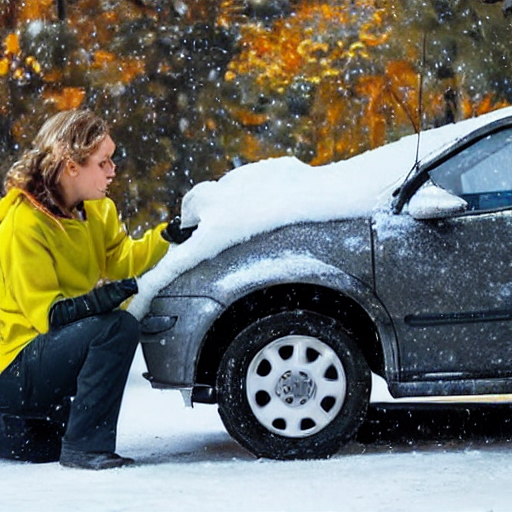Prepare Your Vehicle for Winter: Essential Steps for Safe Driving
The winter season turns our surroundings into breathtaking white landscapes, creating a tranquil setting ideal for cozy evenings by the fire. However, this picturesque season also poses significant challenges, especially for drivers navigating icy roads and dealing with unexpected circumstances. As responsible drivers, it is essential to undertake comprehensive preparations for any situation that may arise during these colder months. Picture yourself trapped in a winter storm, stranded on a lonely road without help—it’s a daunting thought. But fear not! This comprehensive guide will outline the vital actions you need to take to make sure your vehicle is ready for any winter emergency, providing you with the confidence to travel safely all season long.

Ensure Your Safety: Thoroughly Remove Snow and Ice from Your Vehicle
Before you hit the road, it’s crucial to make sure your vehicle is completely clear of snow and ice. Although this task might seem straightforward, many drivers unfortunately overlook this vital step. Snow and ice accumulation on the roof, hood, or windows can drastically impair visibility, leading to perilous driving conditions. In some cases, snow may unexpectedly slide down onto your windshield, causing a sudden loss of sight while driving. Furthermore, large chunks of snow or ice can become dangerous projectiles, posing serious risks to other vehicles on the road. Equip yourself with a sturdy scraper and a brush, and diligently remove all snow and ice from your vehicle’s surfaces. This proactive approach significantly enhances not only your safety but also that of others when driving in winter conditions.
Enhance Traction and Ensure Safety: Perform a Detailed Tire Inspection
Your tires serve as the critical connection between your vehicle and the road, making their condition essential for grip and safety during winter driving. Prior to the arrival of cold weather, it’s vital to assess their condition, ensuring they are well-inflated and in excellent shape. Cold temperatures can cause a drop in tire pressure, which greatly reduces traction on icy or snowy surfaces. Always check the manufacturer’s recommended tire pressure levels, usually found in your vehicle’s manual or a sticker on the driver’s side door jamb.
Moreover, the tread depth of your tires is pivotal for your vehicle’s performance in snowy and icy conditions. While the legal minimum may be 2/32 of an inch, opting for tires with deeper tread can significantly improve grip and handling. Consider investing in winter or snow tires specifically designed for colder conditions to ensure optimal traction and control. Remember, well-maintained tires can be the deciding factor that keeps you safely on the road, preventing dangerous situations during your winter travels.
Battery Preparedness: Guarantee Your Vehicle Starts Every Time
Visualize being all set for your winter adventure only to find that your vehicle won’t start due to a failing battery. Prevent this frustrating scenario by proactively evaluating your battery’s condition before the temperatures drop. Numerous auto parts retailers offer free battery inspections, and taking advantage of this service can ensure your battery is functioning optimally.
Winter weather places additional stress on your battery; therefore, it’s crucial to keep terminals clean and free from corrosion. Look for signs of wear and aging, and make sure all connections are secure. If your battery shows signs of nearing the end of its lifespan, it’s wise to replace it proactively, preventing the risk of being left stranded in the cold with a dead battery. Keeping your battery in excellent condition is vital for reliable winter travel.
Essential Fluids: Maintain Key Vehicle Fluids for Smooth Operation
Maintaining the appropriate levels of essential fluids in your vehicle is critical for optimal operation during winter driving. Start by checking your engine coolant, commonly known as antifreeze, which prevents your engine from freezing. It’s essential to ensure this fluid is at recommended levels for efficient functioning. If unsure about the proper levels, consult your vehicle manual or seek guidance from a qualified professional.
Next, inspect your windscreen washer fluid. Winter roads can quickly become slushy and dirty, obstructing your view. Refill your washer fluid, ideally with a winter blend designed to remain effective even in freezing temperatures. Don’t forget to check your brake fluid and engine oil; ensuring they are at the correct levels is essential since cold temperatures can adversely affect their performance. Properly maintained fluids are crucial for your vehicle’s smooth operation and overall safety, particularly during the winter months.
Emergency Preparedness: Assemble Your Comprehensive Winter Emergency Kit
In the event of a winter crisis, having a well-stocked emergency kit in your vehicle is akin to having a reliable companion by your side. Ensure your kit is equipped with critical items such as a dependable flashlight, extra batteries, jumper cables, a reflective vest, and a warm blanket. Don’t forget to include gloves, a hat, a first aid kit, non-perishable snacks, and water as essential supplies. You might also consider adding a portable phone charger, a compact shovel, and materials like sand or kitty litter to improve traction if you become stuck.
Remember, being prepared for the unexpected is vital for safely navigating winter conditions. Regularly check and replenish your emergency kit to ensure you’re ready to handle any situation that may arise. Taking proactive measures can significantly enhance your safety during winter travel.
Boost Your Visibility: Confirm All Vehicle Lights Are Functioning Properly
With shorter days and extended nights during winter, ensuring your vehicle’s lights are functioning correctly is vital for safety. Take the time to inspect all external lights, including turn signals, brake lights, headlights, and taillights. Replace any dim or burnt-out bulbs to maintain optimal visibility for both yourself and other drivers on the road. Proper lighting not only enhances your visibility while driving but also ensures that you are visible to other drivers, reducing the risk of accidents during critical moments.
Wiper Blades: Guarantee Clear Visibility During Severe Winter Weather
Winter weather often brings snow, freezing rain, and slushy conditions that can severely impair visibility. To combat these challenges, it’s essential to have wiper blades in top working condition. If your current wipers are leaving streaks or failing to effectively clear moisture, it’s time for a replacement. Consider investing in winter-specific wiper blades designed to tackle harsh conditions, as they can significantly enhance visibility during snowstorms and freezing rain, ensuring you can navigate safely.
Stay Informed: Regularly Monitor Weather and Road Conditions
To effectively manage the challenges of winter driving, staying informed about weather updates and potential road closures is crucial. Before embarking on any journey, check the weather forecast and remain aware of possible hazards along your route. Utilizing weather apps, tuning into local news stations, or listening to radio broadcasts can provide you with real-time updates on changing conditions.
Additionally, inform someone of your travel plans, including your intended route and estimated arrival time. This way, should any emergencies occur, someone will know where to look for you. By following these straightforward yet effective tips, you can be thoroughly prepared for any winter emergency, ensuring a safe journey. Remember, it’s always better to be over-prepared than caught off guard. Embrace the beauty of the winter season while ensuring your vehicle is equipped to handle whatever challenges lie ahead. Safe travels!
The post Preparing Your Vehicle: Stay Ahead of Winter Challenges appeared first on Survival Bite.
The Article Preparing Your Vehicle for Winter Challenges Ahead Was Found On https://limitsofstrategy.com


You raise a crucial point about the importance of preparing our vehicles for winter, especially when considering the potential hazards we may face on the road. I’ve found that a common oversight is not just clearing snow and ice from the car’s exterior, but also neglecting the critical systems that keep us safe. For instance, many drivers forget to check their tire pressure regularly; cold temperatures can significantly lower it, leading to diminished traction when we need it most.
You’re spot on about the need to take a closer look at the details when it comes to winter preparedness. It’s so easy to focus on just getting rid of the snow and ice on the outside of our vehicles, but there’s so much more beneath the surface. Tire pressure is an excellent point. Cold weather can really play tricks on us — dropping temperatures can deflate tires almost overnight, making a huge difference in how our cars handle.
Your discussion on preparing vehicles for winter resonates deeply, especially given the increasing unpredictability of winter weather patterns. Personally, I find that the transition to winter driving requires not only physical vehicle preparations but also a mindset shift. For instance, regularly checking the local weather forecasts can help in planning trips around potentially hazardous conditions.
You bring up such an important point about preparing our vehicles for winter driving. It’s something that not many people think about until they’re faced with the challenges of snow and ice. I remember one particularly frigid winter a few years ago; I ignored the advice to clear off my car completely and ended up with a dangerous situation on the highway when a chunk of ice flew off my vehicle and hit the car behind me. Thankfully, no one was hurt, but it made me realize just how crucial it is to take these preparations seriously.